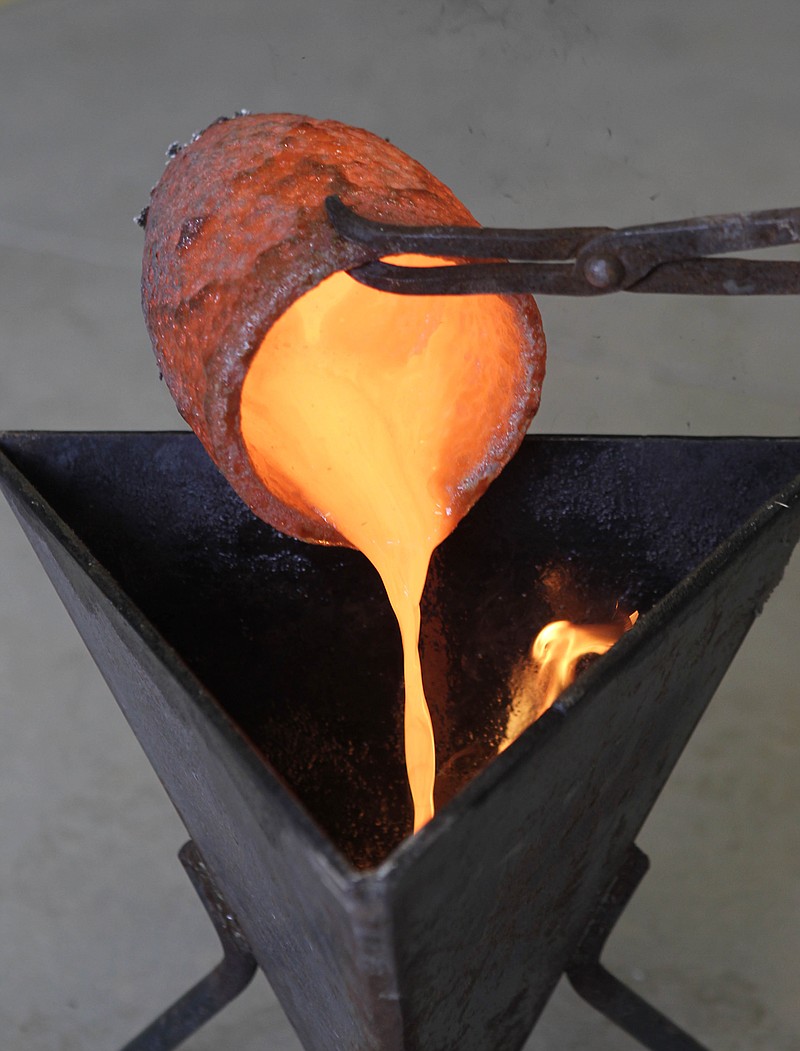SUTTER CREEK, Calif. (AP) - The gold miners who made California famous were the rugged loners trying to shake nuggets loose from streams or hillsides. The ones who made the state rich were those who worked for big mining companies that blasted gold from an underground world of dust and darkness.
The last of the state's great mines closed because mining gold proved unprofitable after World War II. But with the price of the metal near historic highs, hovering around $1,700 an ounce, the first large-scale hard rock gold mining operation in a half-century is coming back to life.
Miners are digging again where their forebears once unearthed riches from eight historic mines that honeycomb Sutter Gold Mining Co.'s holdings about 50 miles southeast of Sacramento. Last week, mill superintendent Paul Skinner poured the first thin stream of glowing molten gold into a mold.
"Nothing quite like it," murmured Skinner, who has been mining for 65 years.
It was just four ounces, culled from more than eight tons of ore, but it signaled the end of $20 million worth of construction and the pending start of production. The company announced the ceremonial first pour before financial markets opened Monday, marking the mine's official reincarnation.
By spring, the company's 110 employees expect to be removing 150 tons of ore a day from a site immediately north of the old Lincoln Mine, enough to produce nearly 2,000 ounces of gold each month.
The company projects reserves of more than 682,000 ounces of gold worth more than $1 billion at today's prices. Company officials say they are confident there is far more in their historically rich section of the 120-mile-long Mother Lode region of the Sierra Nevada foothills.
Reopening the mine has been anything but a gold rush, however.
It took three decades for the mine's operators to obtain more than 40 environmental permits. By contrast, the old Wild West miners wreaked such devastation that they prompted some of the nation's first conservation efforts nearly 130 years ago.
"We've gone from no regulation to probably the other extreme," said Bob Hutmacher, the company's chief financial officer.
In recent decades, most of California's gold has come from the state's desert regions. However, high gold prices recently spurred what authorities say was a rogue surface gold mine in El Dorado County, east of Sacramento. The owners now face criminal charges.
Farther north, several mines have started the process to reopen. Most of these kinds of hard rock mines have recently been known more as tourist destinations, including the Empire Mine, which was once the state's largest hard rock mine. It became a state historic site after it closed in 1956.
Sutter Gold's mine also hosted underground tours featuring gold mining history until about a year ago. A half-million people took the tours before they were halted for insurance reasons as the company scrambled to begin production.
Miners have now burrowed more than a half-mile underground and are digging another half-mile network of tunnels to reach the milky white quartz deposits that contain the gold.
Six-hundred vertical feet underground, Keith Emerald was soaking wet in a T-shirt, rubber boots and bib overalls in the damp, chilly mine.
The only light came from his battery-operated hardhat headlamp as he leaned into a deafening 135-pound jackleg pneumatic drill, driving an 8 1/2-foot-long bit repeatedly into a wall of solid rock. The more than 30 holes he drilled were packed with explosives to reduce a head-high archway to rubble.
"Fire in the hole," came a disembodied voice over the mine's radio system hours later.
The miners are using tools like the jackleg drill that have changed little in a century because they are searching for relatively narrow bands of quartz, averaging 2.4 feet wide. That makes it too costly to use modern mechanized equipment that would churn out tons of worthless rock.
"This harkens back to the 19th century where you follow the gold veins," said chief operating officer Matt Collins. "We're throwbacks."
Their predecessors pried 3.5 million ounces of gold from the ground underlying the company's holdings before the last mine, the Eureka, closed in 1958.
The company has mining rights under about 4.5 miles of the Mother Lode between the quaint Gold Rush communities of Sutter Creek, population 2,500, and Amador City, with 200 residents. The mining area roughly parallels Highway 49, named after the miners who rushed to California from around the globe after gold was discovered in 1849.
Sutter Creek is the namesake of John Sutter of gold discovery fame. The nearby mines once made Hetty Green the nation's richest woman and propelled the success of railroad baron Leland Stanford, who went on to become governor and found Stanford University.
Now the towns boast more about their proximity to foothill wineries and the restaurants, boutiques and antique stores that line their historic main streets.
"(Highway) 49 is known as the Gold Rush road. If there's gold to be found, I think it should be mined," said Jan Hicks, who lives in nearby Jackson but clerks in an 1869 Amador City building that once housed a general store catering to miners.

